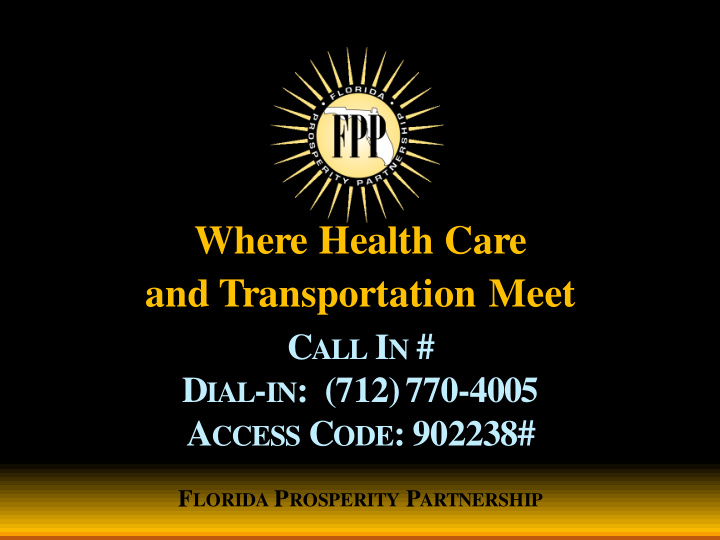



Where Health Care and Transportation Meet C ALL I N # D IAL - IN : (712) 770-4005 A CCESS C ODE : 902238# F LORIDA P ROSPERITY P ARTNERSHIP
B ILL M ILLS P RESIDENT /CEO F LORIDA P ROSPERITY P ARTNERSHIP F LORIDA P ROSPERITY P ARTNERSHIP
T HE FPP IS FUNDED BY : & Y OU ! F LORIDA P ROSPERITY P ARTNERSHIP
C HRISTINE R AMA M EMBERSHIP D IRECTOR F LORIDA P ROSPERITY P ARTNERSHIP F LORIDA P ROSPERITY P ARTNERSHIP
An Introduction Who We Are The Florida Prosperity Partnership (FPP) is a statewide collaboration of more than 750 organizations from all sectors of the community, focused on improving the financial stability of Floridians . OUR MISSION Providing pathways to economic security through a statewide coalition of organizations. 5
Platforms for Prosperity ▪ Based on a concept by the Corporation for Enterprise Development (CFED) ▪ Moves individuals and families from poverty to economic success ▪ Includes proven and emerging asset-building strategies are integrated into the places where peoples already spend their time 6
Does poor health lead to financial insecurity or the reverse? The correlation between poor health and poverty is unmistakable Rutgers reported: ▪ Overdue medical bills can result in physical symptoms of stress and/or delayed or inadequate treatment ▪ High health costs can lead to a poor credit history and reduced income ▪ Medical problems were found to be associated with about half the cases of bankruptcy filed in 2001 Stanford reports : ▪ Health (and mental health) along with transportation are both key “issues in poverty/inequality.” 7
Transportation is the link between all of the Platforms for Prosperity In the interest of improving the financial stability and well-being of Floridians, FPP seeks to map the current assets, including: ▪ Available healthcare services for low income populations ▪ Available transportation 8
Kiara Zambrana: Intern, FPP Kiara Zambrana is a rising senior at William R. Boone High School in Downtown Orlando. She is a part of the Academy of Finance, a program led by Bill Daniel. Through this program, high school students are taught Accounting, Finance, Personal Finance, and AP Macro and Micro Economics over the course of four years. Currently, Kiara is president of the Boone French Honor Society, a varsity runner on the cross country team, a member of the National Honor Society, a member of HOSA Future Health Professionals, a member of French Club, an AP student, and an avid piano player. 9
Thank You Many thanks to the following people without whom this research project and webinar would not be possible: ▪ Jessie Ball DuPont ▪ Bill Daniel ▪ Patricia Breeding ▪ Bill Mills ▪ Christine Rama ▪ Orange County Public Schools ▪ Heart of Florida United Way 10
The “Why?” ▪ Purpose: Find gaps (if any) between health care and transportation in FL for low-moderate income people • Health Care, Transportation, Financial Stability ▪ Method: 100+ hours of research on all 67 counties ▪ Presentation: • Excel spreadsheet: Clinics, Transportation, Car Buying Programs • Research Paper • Webinar 11
Not a Comprehensive List • We hope that this project will inspire more research on the topic. • The spreadsheet of information should be treated as a living document, continually being updated. 12
Health Care Population in Clinics= Primary An average of Round to 100 Clinics will be X 52 weeks serving more poverty based Care, STD and TB 89 patients clinics, Pediatric seen by primary in a year X 2 people: 200% on federal poverty levels Care, Dental care Doctors = 10,400. of poverty Strain on level, sliding Care, and More per week clinics scale, free clinics for the homeless, etc. 13
Health Care • Services Provided: • Different services make a more complicated picture • Locations: • Some counties have a high concentration of clinics in one city • Duval County-Jacksonville • Struggles • Disconnected phone numbers • Out of date websites 14
Transportation Disadvantaged • A program designed to provide transportation for those unable to transport themselves to life-sustaining activities. • Definition of TD: “Persons who because of physical or mental disability, income status, or age are unable to transport themselves or to purchase transportation and are, therefore, dependent upon others to obtain access to health care, employment, education, shopping, social activities, or other life-sustaining activities, or children who are handicapped or high-risk or at- risk as defined in s. 411.202” • The program: • Shared ride, curb to curb service • Discounted fare on regular public transit 15
Transportation Disadvantaged ▪ Struggles • Trying to Google search • Out of date website links on DOT website • An emphasis on elderly customers • Patience in using the services • “No - show” policies 16
Other Forms of Transportation • Public transportation • Fixed route buses • Trolleys • Shuttles • Trains • Car buying programs (limited) • Loans at 9.9-15% for those with no or bad credit • Receive a used car for a low payment • Must take financial literacy classes and be employed 17
Future Work • We welcome any information that will help this project become more comprehensive. • Free and reduced cost clinics • Low cost forms of transportation • Transportation programs for those with low-moderate income • Ideas on how to make this information more accessible 18
Closing Remarks • Thank you all for taking the time to be part of this webinar! • Follow this link: http://www.floridaprosperitypartnership.org/PRESENTA TIONS to view the Excel spreadsheet and research paper • Please feel free to ask any questions that you may have. 19
Recommend
More recommend